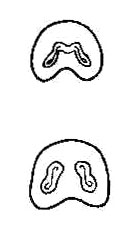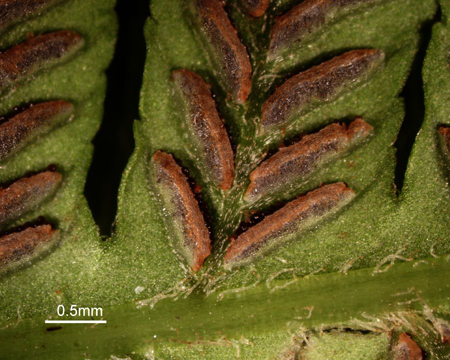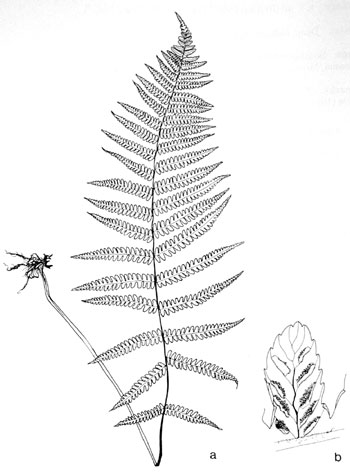|
Hardy Fern Home D. acrostichoides resources All Ferns � Woodsiaceae �� Deparia
�Other Genera
|
| Deparia acrostichoides | ||
Silvery glade fern, silvery spleenwort | ||
|
Etymology
Acrostichoides describes the resemblance to the fern genus Acrostichum.
Description
Rhizome: short-creeping, about 15 mm diam.,stipes about 1 cm. apart, forming an asymmetric clump, scaly.
Frond: 110 cm high by 20 cm wide, deciduous, somewhat dimorphic, fertile fronds longer, more erect, earlier, than sterile, blade/stipe ratio: 3:1. Stipe: dark red-brown at base, straw-colored above, then green, swollen, with 2 rows of teeth, shallowly grooved above, scales at base light brown, lanceolate, vascular bundles: 2, curved or peanut-shaped, at an acute angle, uniting to a u-shape above. Blade: 1-pinnate-pinnatifid, elliptic to ovate-lanceolate, tapering to both ends, herbaceous, multi-cellular hairs along costae. Pinnae: 20 to 25 pair, alternate, oblong, truncate at the base, long-tapering; costae grooved shallowly above, discontinuous from rachis to costae, hairs on costae, costules; margins two forms: entire, rounded tip in the first, toothed, pointed in the second; veins free, little forking. Sori: elongate, � straight, or hooked at distal end, arranged generally in a herringbone pattern, originating on the midvein of the pinnule, indusium: linear, persistent, numerous, whitish when young, giving rise to the 'silvery' epithet, dark brown later, thick, along the vein, opening outward, sporangia: brownish early, later blue-gray, maturity: mid to late summer. Dimensionality: lower pinnae pointing downward, forward above the plane. Culture
Habitat: damp woods, often on slopes .
Distribution: eastern and northeastern North America.
Hardy to -35�C, USDA Zone 3.
Distinctive Characteristics
the young indusia silvery (Cody and Britton, Ferns and Fern Allies of Canada, report it is the old indusia which are silvery.)
Synonyms
Asplenium acrostichoides Swartz Athyrium acrostichoides (Swartz) Diels Athyrium thelypterioides (Michaux) Desvaux Diplazium acrostichoides (Swartz) Butters |
|
|

Deparia acrostichoides. Two oblong or slightly s-shaped vascular bundles, back to back at the base of the stipe, uniting upward at the back of the stipe. �Drawing from Ferns of Northeastern United States, Farida A. Wiley, 1936. |
Deparia acrostichoides. Frond. �Web pages of the Connecticut Botanical Society |

Deparia acrostichoides, sori fully mature, white to translucent scales on veins �Robbin Moran |
